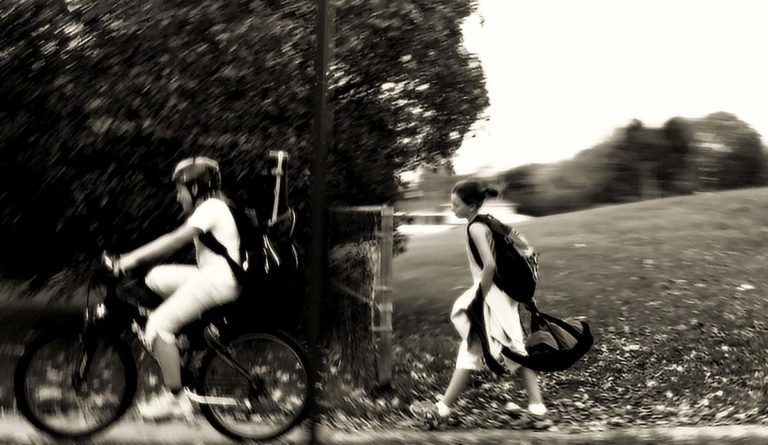Active Transportation Presents New Opportunities
As the culture of activities of our children changes, alternative methods can encourage more physical activity.

Read Time: 6 minutes
Published:
The concern for children’s activity habits continues to grow, as less than half of children meet the recommended amounts of physical activity. Children who do not engage in adequate amounts of physical activity are susceptible to chronic illness, cardiovascular disease, diabetes, cancer, and other comorbidities. Sadly, gone are the days of children running and playing in the streets of their neighborhoods after school each night, as recreational physical activity has shifted to six or more hours of sedentary screen time each day. As the culture of activities and preferences of our children changes, it is becoming increasingly necessary to utilize alternative methods that allow children to perform more physical activity in order to safeguard their health both now and in the future.
Public schools offer a great opportunity to do just that, as millions of children in our country spend much of their time in an academic setting during the school year. Many programs exist that attempt to increase physical activity during the school day through programs held before or after school, recess, physical education classes, or physical activity incorporated into classroom lessons. Another approach to increasing the physical activity of school children that is often overlooked is their transportation to and from school.
Active transportation is defined simply as using a non-motorized method to get to or from school, such as walking or riding a bicycle. This is a great opportunity for children to transform a sedentary activity into one that increases their participation in physical activity. However, research shows that only about 5–21% of children in the United States use an active method to get to or from school. This low percentage indicates that active transportation represents a fitting opportunity to increase the physical activity of schoolchildren.
Physical environmental characteristics such as a lack of sidewalks or crosswalks are prohibitive to participating in active transportation. Clearly, there is room for improvement when it comes to designing our infrastructure to accommodate active transportation methods.
In order to take full advantage of this opportunity, we must examine the perceived barriers children face when attempting to participate in active transportation when traveling to or from school. One commonly named barrier is a built environment that is unfavorable to walking or bicycling. Children are sometimes made to take indirect routes to school due to the neighborhood design which can be perceived as being more dangerous for young children. Physical environmental characteristics such as a lack of sidewalks or crosswalks are prohibitive to participating in active transportation. Clearly, there is room for improvement when it comes to designing our infrastructure to accommodate active transportation methods.
However, a recent study by Behrens et al. has shown that the built environment is not the only factor that affects the probability of participation in active transportation. Differences in gender and age have been identified in this study as characteristics likely to influence whether or not a child is likely to walk or bike to school. It was found that boys rode their bicycles to school more often than girls, and amassed more walking time than girls. A different study indicates that these results could be attributed to differences in confidence levels between males and females, in addition to the finding that males generally engage in more vigorous physical activity. These findings as a whole coincide with existing literature that suggest males are more likely to be physically active than females, despite being given equal opportunities for physical activity. Moreover, these findings justify the development and implementation of interventions targeted at females to promote increased active transportation.
Apart from gender, mixed findings have been published regarding whether active transportation increases as children grow older, as noted in the study by Behrens et al., or decreases as children get older, as noted in other studies found in the literature. However, it is possible that these conflicting findings could be attributed to differences in the built environments of the areas of study, since some areas are certainly better suited for active transportation than others. In conjunction with the built environment, factors such as proximity to school and perceived safety by parents have been identified in this study and others as common concerns with respect to the likelihood of engaging in active transportation. Considering that perceptions of the built environment and the built environment itself appear to be recurring barriers to active transportation, policy changes in support of large-scale environmental interventions to increase active transportation should be considered.
Policies that support a sufficient built environment play a significant role in the success of active transportation initiatives. For instance, improvements in sidewalks, bike paths, traffic lights, and pedestrian crossing regulations have all been found to increase the likelihood of children’s active transportation to and from school. In addition to improving health behaviors, these types of policy actions would be effective in addressing concern over child safety during active transportation to and from school. The recent study published by Behrens et al. found that regardless of school location or proximity, perceptions of safety by parents could mean the difference between driving and actively commuting to school. Ultimately, policies that function to address safety concerns and support infrastructure improvement (e.g. sidewalks/routes in the vicinity of schools) are imperative to the success of active transportation initiatives.
Aside from improving child safety during regular commutes to and from school, policies that allow for effective active transportation may also help to reduce traffic congestion, air pollution, and fuel costs.
The successful implementation of active transportation initiatives on account of policy change also presents an opportunity for other health-improving benefits, which may even be attributable to the larger population. Aside from improving child safety during regular commutes to and from school, policies that allow for effective active transportation may also help to reduce traffic congestion, air pollution, and fuel costs [10]. The development and implementation of policies conducive to facilitating sufficient active transportation initiatives presents a realistic opportunity to enhance the health and well-being of school-aged children and the greater public.
As the widespread problem of inactivity among youth progresses, it is important to examine the merits of often-overlooked methods to combat increased sedentary behavior, such as active transportation. This information is helpful to school administrations, community planners and developers, policy makers, and concerned parents who could help to organize active transportation groups to or from school so that children may participate in physical activity like active transportation safely and efficiently. In an ever-changing world, those familiar with the benefits of active transportation have the power to develop policies and institute positive changes that contribute to an improved physical environment conducive to increasing physical activity among schoolchildren.
Feature image: pawpaw67, Walking Home, used under CC BY-SA 2.0/cropped from original





